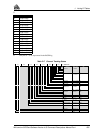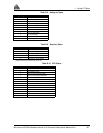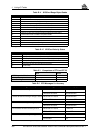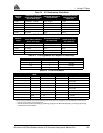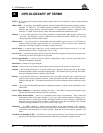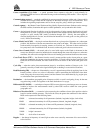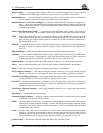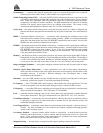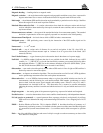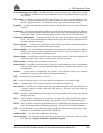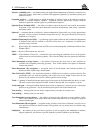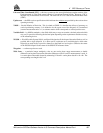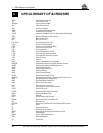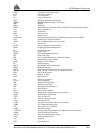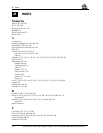
K GPS Glossary of Terms
MiLLennium GPSCard Software Version 4.50 Command Descriptions Manual Rev 1 263
Geostationary — a satellite orbit along the equator that results in a constant fixed position over a particular
reference point on the earth’s surface. (GPS satellites are not geostationary.)
Global Positioning System (GPS) — full name NAVSTAR Global Positioning System, a space-based radio
positioning system which provides suitably equipped users with accurate position, velocity and time
data. When fully operational, GPS will provide this data free of direct user charge worldwide,
continuously, and under all weather conditions. The GPS constellation will consist of 24 orbiting
satellites, four equally spaced around each of six different orbiter planes. The system is being
developed by the Department of Defence under U.S. Air Force management.
Great circle — the shortest distance between any two points along the surface of a sphere or ellipsoid, and
therefore the shortest navigation distance between any two points on the Earth. Also called Geodesic
Line.
HDOP — Horizontal Dilution of Precision - A numerical value expressing the confidence factor of the
horizontal position solution based on current satellite geometry. Makes no constraint assumptions
about time, and about height only if the FIX HEIGHT command has been invoked. The lower the
HDOP value, the greater the confidence in the solution.
HTDOP — Horizontal position and Time Dilution of Precision - A numerical value expressing the confidence
factor of the position solution based on current satellite geometry. Assumes height is known if the
FIX HEIGHT command has been invoked. If not, it will give the normalized precision of the
horizontal and time parameters given that nothing has been constrained. The lower the HTDOP
value, the greater the confidence factor.
Heading — the direction in which a vessel points or heads at any instant, expressed in degrees 000° clockwise
through 360° and may be referenced to True North, Magnetic North, or Grid North. The heading of
a vessel is also called the ship's head. Heading is a constantly changing value as the vessel oscillates
or yaws across the course due to the effects of the air or sea, cross currents, and steering errors.
Integer Ambiguity Estimates — carrier phase ambiguity estimates which are only allowed to take on integer
values.
Iono-free Carrier Phase Observation — a linear combination of L1 and L2 carrier phase measurements
which provides an estimate of the carrier phase observation on one frequency with the effects of the
ionosphere removed. It provides a different ambiguity value (non-integer) than a simple
measurement on that frequency.
Kinematic — the user’s GPS antenna is moving. In GPS, this term is typically used with precise carrier phase
positioning, and the term dynamic is used with pseudorange positioning.
L1 frequency — the 1575.42 MHz GPS carrier frequency which contains the course acquisition (C/A) code,
as well as encrypted P-code, and navigation messages used by commercial GPS receivers.
L2 frequency — a secondary GPS carrier, containing only encrypted P-code, used primarily to calculate signal
delays caused by the ionosphere. The L2 frequency is 1227.60 MHz.
Lane — a particular discrete ambiguity value on one carrier phase range measurement or double difference
carrier phase observation. The type of measurement is not specified (L1, L2, L1-L2, iono-free)
Local Observation Set — an observation set, as described below, taken by the receiver on which the software
is operating as opposed to an observation taken at another receiver (the reference station) and
transmitted through a radio link.
Local Tangent Plane — a coordinate system based on a plane tangent to the ellipsoid’s surface at the user’s
location. The three coordinates are east, north and up. Latitude, longitude and height positions
operate in this coordinate system.
Low-latency Solution — a position solution which is based on a prediction. A model (based on previous
reference station observations) is used to estimate what the observations will be at a given time
epoch. These estimated reference station observations are combined with actual measurements
taken at the remote station to provide a position solution.
Magnetic bearing — bearing relative to magnetic north; compass bearing corrected for deviation.



